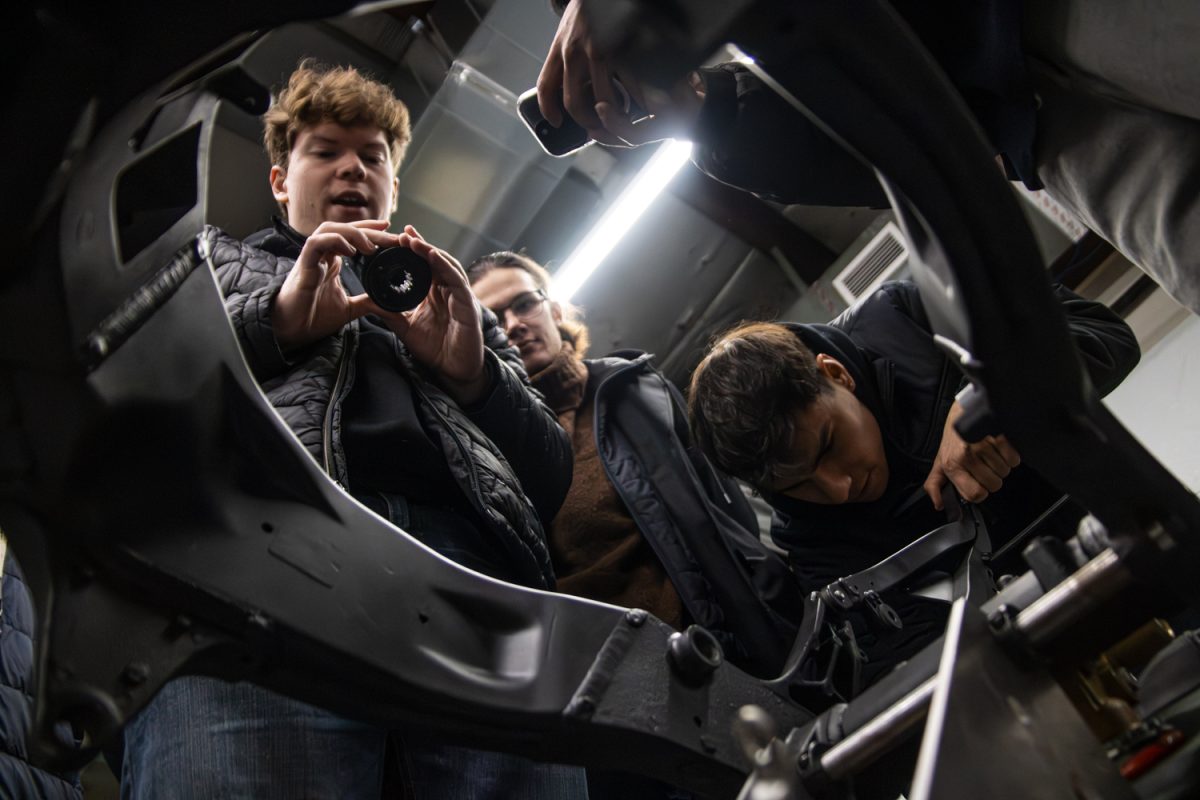Julia is from Nicaragua and earns $430 a year. She is one of roughly 1 billion people on the world who lives in poverty. Julia’s story and similar accounts were printed on small white paper cards and randomly handed out to 50 percent of the students who attended the Service and Justice Outreach Hunger Banquet on Tuesday. The white cards represented the portion of the world’s population living on a low income.
Participants who received the cards were asked to sit on the floor in the middle of the Monsignor Sweatland room at Newman Hall. Later, the group would sit around two bowls of cooked rice and share the modest dinner with one another.
Those fortunate enough to receive a yellow card, about 35 percent of the banquet’s attendees, represented the world’s population that earns a middle-income. They sat in rows of chairs to eat their dinner. They added beans to their rice and were served water, while the few remaining guests who represented the world’s high-income population sat at candlelit tables with decorative cloths and a catered pasta meal from a local restaurant.
The event organizers said they hoped the banquet helped participants look at hunger and poverty from a different visual perspective.
“Some people may live in a middle-income lifestyle, but they don’t realize how much less other people have,” Kelly Cramsey, junior in LAS and co-host of the Hunger Banquet, said.
Get The Daily Illini in your inbox!
“It’s kind of bringing that to the forefront and it will help (the guests) realize how big of an issue world hunger is.”
This is the second year the outreach held the banquet. This year, the group teamed with the American Medical Students Association to organize the event. They met for three months, preparing the night’s events and asking local organizations and restaurants to donate food.
The banquet was sponsored by Oxfam America, a hunger relief organization that provided the groups with a script, statistics and informational brochures on poverty and world hunger. Banquet participants were also asked for donations that would be sent to Oxfam.
Before dinner was served, student organizers presented facts about hunger and how events such as the banquet help bring awareness to what they said is an overlooked issue.
Rebecca Houghton and classmate Rebecca Lemkau, both juniors in LAS, said they thought the statistics were striking. Houghton said she was surprised to learn that the United States poverty line is slightly lower than the world’s high-income level.
“That was a little wowing,” Houghton said.
Other facts stated that some people shift between income statuses and that one person with a middle-income could easily fall to low-income status and vice versa.
To emphasize the message, three people from the low-income group and three people from the middle-income group were asked to stand up and switch places. Houghton and Lemkau were chosen to move from low-income to middle-income status and eat the middle class meal.
“It was nice not to sit on the floor,” Lemkau said. She added that initially, she hoped to eat the high-income dinner. “I was jealous of the high class people with their nice candles and tables and chairs.”
Low-income guests formed a circle around the large tin bowls of rice and served themselves. Some opted to eat with their hands while others used spoons. As a selection of world music played with images of citizens of poor nations, the group mingled with the others who represented 50 percent of the world’s population.
Kevin Smith, a senior in LAS, was given a red high-income card. He said he felt sorry for those sitting on the floor.
“I felt a little guilty because I was at the high-income table, but I thought it (still) provided a good visual representation, Smith said.
“You hear a lot of statistics and they use words like ‘billions of people’ and ‘hundreds of millions of people,’ but that’s impossible to conceptualize.”
Smith and the other five guests who sat at the high-income table were served salad with croutons and pasta with meat sauce. The group represented only 15 percent of the night’s attendees.
More information on world hunger and statistics was presented throughout the night. Representatives from hunger relief organizations also presented ways that people can help those who are hungry.
Johan Tota, a board member for Service and Justice Outreach and the event’s co-host, said he remembered members of the high-income dinner sneaking food to the lower income members at last year’s banquet. Not this year, he said. He noticed that many of the low-income diners were enjoying themselves.
“When I looked across at the people sitting in the circle (on the floor) and the music was going and people were having fun, I was like ‘Great. People had fun at the event.”





